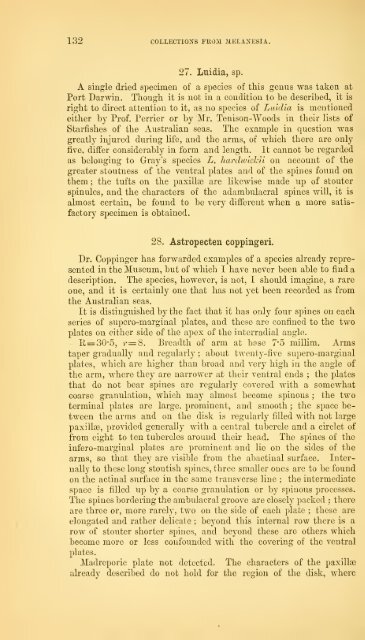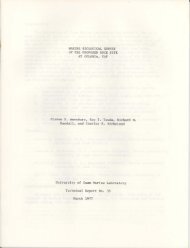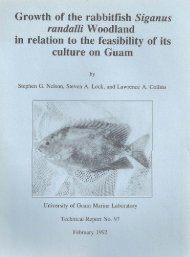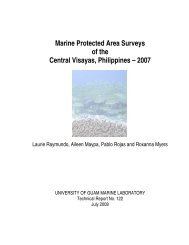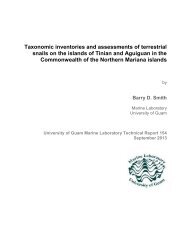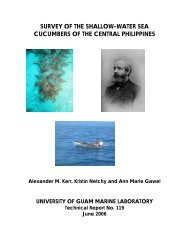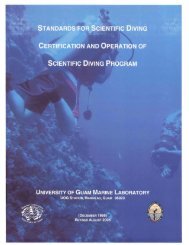You also want an ePaper? Increase the reach of your titles
YUMPU automatically turns print PDFs into web optimized ePapers that Google loves.
132 C0LLECTI0X8 FROM MELANESIA,<br />
27. Luidia, sp.<br />
A single dried specimen of a species of this genus was taken at<br />
Port Dar\vin. Though it is not in a condition to be described, it is<br />
right to direct attention to it, as no species of Luidia is mentioned<br />
either by Prof. Perrier or by Mr. Tenison-Woods in their lists of<br />
Starfishes of the Australian seas. The example in question was<br />
greatly injured during life, and the arms, of which there are only<br />
five, differ considerably in form and length. It cannot be regarded<br />
as belonging to Gray's species L. hardwiclcii on account of the<br />
greater stoutness of the ventral plates and of the spines found on<br />
them ; the tufts on the paxillee are likewise made up of stouter<br />
spinules, and the characters of the adambulacral spines will, it is<br />
almost certain, be found to be very different when a more satis-<br />
factory specimen is obtained.<br />
28. Astropecten coppingeri.<br />
Dr. Coppinger has forwarded examples of a species already represented<br />
in the Museum, but of which I have never been able to find a<br />
description. The species, however, is not, I should imagine, a rare<br />
one, and it is certainly one that has not yet be-en recorded as from<br />
the Australian seas.<br />
It is distinguished by the fact that it has only four spines on each<br />
series of supero-marginal plates, and these are confined to the two<br />
plates on either side of the apex of the interradial angle.<br />
Iiz=30"5, r=8. Breadth of arm at base 7*5 millim. Arms<br />
taper gradually and regularly ; about twenty-five supero-marginal<br />
plates, which are higher than broad and very high in the angle of<br />
the plates<br />
the arm, where they are narrower at their ventral ends ;<br />
that do not bear spines are regularly covered with a somewhat<br />
coarse granulation, which may almost become spinous ; the two<br />
terminal plates are large, prominent, and smooth ; the space between<br />
the arras and on the disk is regularly filled with not large<br />
paxilla3, provided generally with a central tubercle and a circlet of<br />
from eight to ten tubercles around their head. The spines of the<br />
infero-marginal plates are prominent and lie on the sides of the<br />
arms, so that they are visible from the abactinal surface. Internally<br />
to these long stoutish spines, three smaller ones are to be found<br />
the intermediate<br />
on the actinal surface in the same transverse line ;<br />
space is filled up by a coarse granulation or by spinous processes.<br />
The spines bordering the ambulacral groove are closely packed ; there<br />
are three or, more rarely, two on the side of each plate ; these are<br />
elongated and rather delicate ; beyond this internal row there is a<br />
row of stouter shorter spines, and beyond these are others which<br />
become more or less confounded with the covering of the ventral<br />
plates.<br />
Madreporic plate not detected. The characters of the paxillse<br />
already described do not hold for the region of the disk, where


